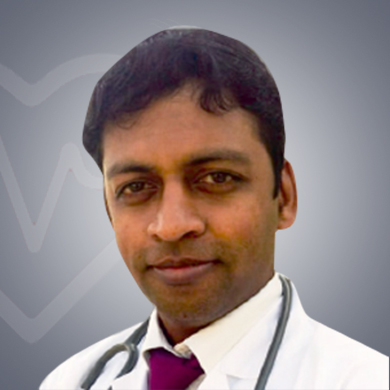
Medical Oncologist
BGS Gleneagles Global Hospitals , Bangalore, India10 Years of experience
Speaks: English
Please have a look at the various types of conditions treated by Dr. Rajeev Vijayakumar,:
These doctors are known to manage the treatment of blood disorders and those of the lymphatic system i.e., vessels and lymph nodes. The three kinds of cancer for which the doctor can refer you to a Hematologist are Multiple Myeloma, Leukemia and Lymphoma. Red blood cells and Hemoglobin related conditions such as thalassemia, sickle cell anemia and anemia are also the conditions for which a Hematologist should be approached.
There are several signs and symptoms which indicate that a visit to a Hematologist is necessary.
Night sweats, fever and continuing fatigue are signs that all is not well with the patient and he might have a condition that a Hematologist can help treat.. Symptoms like shortness in breathing and weight loss that cannot be unexplained away by natural reasons can be a direction for you to visit a hematologist. Kindly see a hematologist as soon as possible if you are having some of these symptoms.
The doctor is available for consultation and operation from 9 am to 1 pm on Sunday and from 9 am to 6 pm from Monday to Saturday. The doctor's strength is in the varied and indepth experience, being well educated, skills and expertise.
The popular procedures performed by Dr. Rajeev Vijayakumar are as follows.
The specialty of the doctor is to provide treatment to people for blood disorders and procedures refer to these. Abnormal tissue is removed through cold, lasers, heat or chemicals and the procedures so performed are called Ablation therapy. Of the many popular procedures that are done by Hematologists, bone marrow transplant and blood transfusion are also two important ones.

Share Your Experience about Dr. Rajeev Vijayakumar

Several blood and lymphatic system related disorders are researched upon and diagnosed by a Hematologist. They also give the right medical treatment and do certain operations that are needed for your blood, bone marrow and lymphatic system. The doctors also work in tandem with some other specialists to manage your condition or to interpret the test results for you. A Hematologist also treats you for conditions like Sepsis, an infection reaction and Hemophilia, blood clotting disorder which is genetic.
The tests required before and during consultation for a Hematologist are as follows:
When the aim is to check you for clotting and bleeding disorders, it is tests like Prothrombin time and Partial thromboplastin time that do so. All three blood cells related characteristics and numbers are monitored through a test called as a complete blood count. Bone marrow biopsy helps in diagnosing and monitoring several conditions like blood disorders, bone marrow disorders, some cancers and infections in the bone marrow.
Post tests and consultation with your primary care physician you could be referred to a Hematologist if the doctor realises that your conditions are linked to blood, bone marrow or lymphatic system. Please confer with a Hematologist if you are either suffering from sickle cell anemia or anemia. Leukemia, lymphoma, or multiple myeloma (bone marrow, lymph nodes, or white blood cells) cancers also mean that you must get refer a Hematologist. As soon as the symptoms become more obvious you must go to see this specialist.